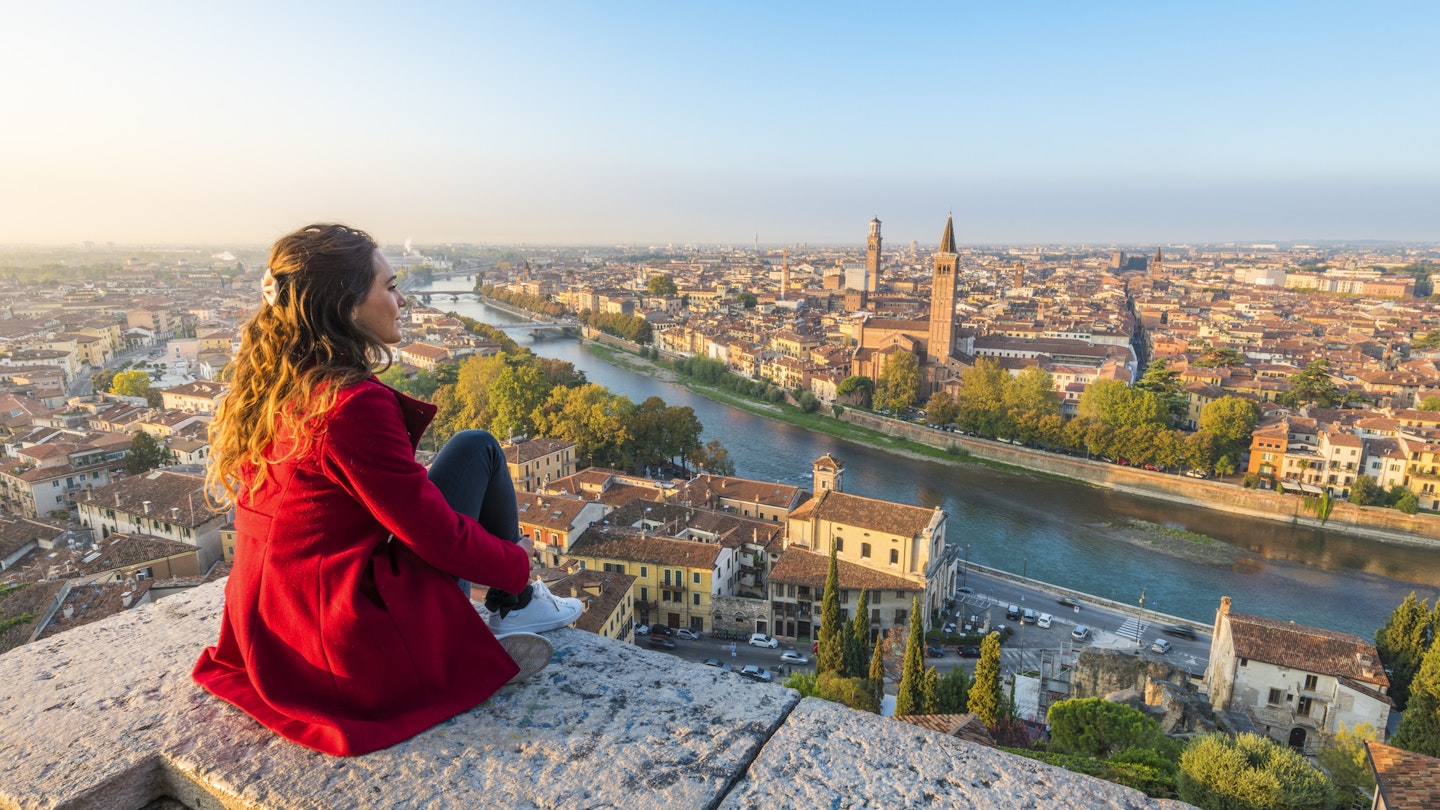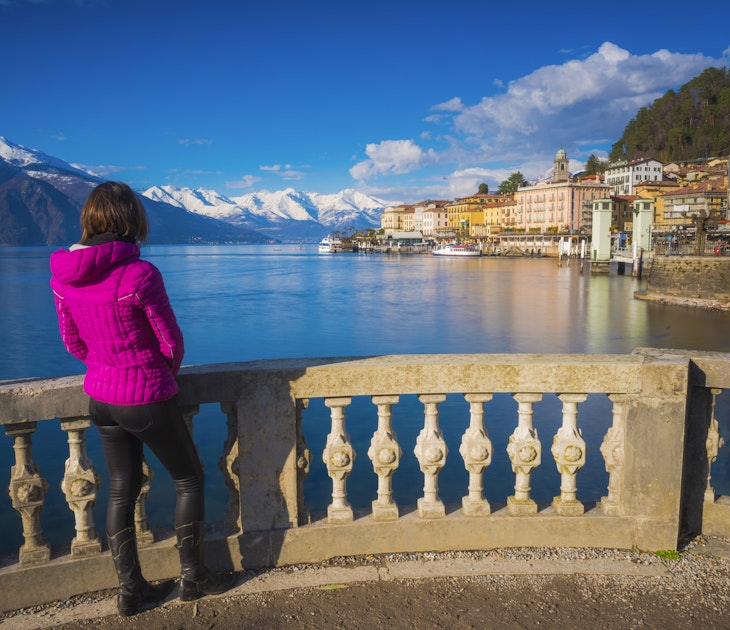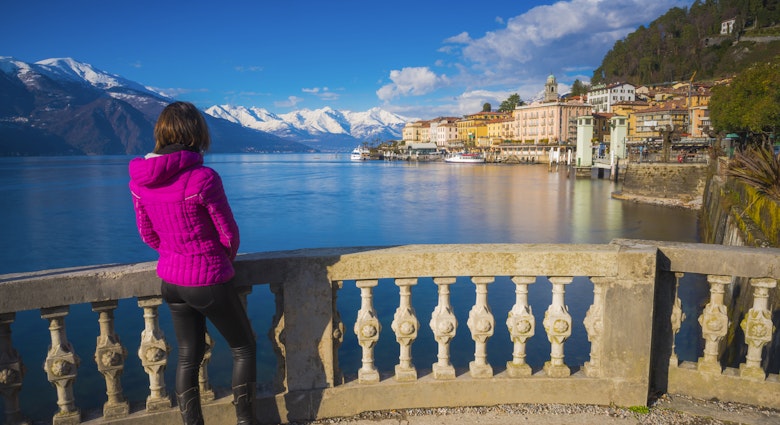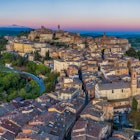Venice is one of the world’s greatest cities – a floating work of art, an open-air museum, and a place that everyone wants to visit at least once in their lifetime.
But what makes it great also makes it crowded...and then some. This fragile city is the poster child for overtourism and not only is it unpleasant to be part of that, but a whistle-stop tour of the sights makes you part of the problem. Our advice? Stay longer. A week is a decent amount of time to get a feel for the real Venice, beyond the crowds, and to take a couple of day trips beyond the canals.
The Italian railway system is excellent and in this part of the country, there are regular high-speed trains that can whisk you to another world in less than half an hour. Whether you’re looking for somewhere close by or fancy a day out in another region or even in the mountains, here are some of the best places to go.
1. See world-changing art in Padova
Travel time: 26 minutes by train
If it wasn’t so close to Venice, Padova (or Padua) would be one of northern Italy’s most feted cities. As it is, not many tourists make it to the place that changed art history – yet it’s one of the easiest day trips from Venice by train. Here, in the Cappella degli Scrovegni – the chapel of the Scrovegni banking family, which now sits in a little park, just 10 minutes’ walk from the train station – Giotto spent two years from 1303 to 1305, frescoing it from top to bottom. What he produced shattered medieval artistic conventions, introducing perspective and humanizing his figures, instead of keeping them stiff and sculptural. If his Nativity and Flight to Egypt scenes are familiar, that’s because they make regular appearances on Christmas cards around the globe.
Other sights include the colossal Basilica di Santa'Antonio – where the remains of St. Anthony of Padua are kept – and Prato della Valle, a huge square (said to be Europe’s largest) where grand statues of local luminaries stand guard over a moated island (join the locals and buy a pizza at nearby Pizzeria Orsucci, going strong since 1922, and eat it in the square). Don’t miss Piazza delle Erbe, where there’s still a busy food market, both inside and out. Looking for souvenirs? La Bottega del Pane is a pantry of exceptional local foods.
How to get to Padova from Venice: The easiest way to get there is by train. Fast trains can take as little as 26 minutes, and slower (cheaper) regional trains can take double that time.
2. Pay homage to Romeo and Juliet in Verona
Travel time: 72 minutes by train
In fair Verona, where we set our scene, little has changed since the 16th century, when Shakespeare set Romeo and Juliet here. The Piazza delle Erbe still hosts a lively market beneath its frescoed palazzos; the Adige river still loops around the elegant center; and the Giardino Giusti’s impeccably laid out garden hasn’t undergone anything more radical than a trim in 500 years. Juliet may not have existed in real life but her spirit lives on in Verona, where "Juliet’s House" – complete with balcony, of course – lures visitors, and a bronze statue is said to bring love to those who rub its breast (nobody could accuse Italy of being politically correct).
Verona may be known as a romantic getaway, but its real attraction is its Roman amphitheater, the Verona Arena, constructed from rosy-pink stone from a local quarry. Back in the day it put on gladiator battles; today, it’s rather more sophisticated, hosting an annual opera festival that’s one of Italy’s iconic summer events.
How to get to Verona from Venice: The train is the fastest and easiest way to get there. There are fast trains (the Milan-Venice route stops at Verona) or slower, cheaper regional ones. The journey ranges between 72 minutes and nearly two and a half hours.

3. See bombastic Renaissance architecture in Vicenza
Travel time: 44 minutes by train
Just as Padova is overshadowed by Venice, Vicenza is the often overlooked sibling of nearby Verona. It wasn’t like this 500 years ago, when the local dignitaries were building palazzos, each grander than the last along what was the Roman decumanus (main drag) and is now called Corso Palladio, after Renaissance starchitect and adopted vicentino, Andrea Palladio.
Today, you can still walk along the street, just as they did – the only thing that’s changed is that it’s now pedestrianized and the “most elegant street in Europe,” according to 19th-century historian Cesare Cantù. The jewel in Vicenza’s crown, though, is the Teatro Olimpico – a jaw-dropping theatre by Palladio, its interior crafted entirely from wood, stucco and plaster to aid the acoustics. Its trompe l’oeil stage set is the oldest in the world. If you have a car, it’s worth driving around the countryside, which is littered with sumptuous villas also designed by Palladio – La Rotonda is one of the finest.
How to get to Vicenza from Venice: Fast trains from Venice are quick (from 44 minutes) and easy, or it’s a 50-minute drive.
4. Hit the water at Lake Garda
Travel time: 93 minutes by train
Yes, you can do a day trip from Venice to Lake Garda – in fact, Italy’s largest lake makes for a fun day trip on public transport. Take the train to Desenzano, from where the (water) world is your oyster. Ferries zigzag across the lake – top stops include Lazise, a picture-perfect village on the crystal clear water; Gargnano, where you’ll find Limonaia La Malora, one of the only remaining lemon groves which Garda used to be famous for; and Limone sul Garda, where there’s a footpath cantilevered over the water on the outskirts of town.
At Sirmione, a peninsula thrusting out into the lake from the southern shore, there are the remains of a Roman villa, the Grotte di Catullo, while on a hill above Gardone Riviera is the Vittoriale, the former home of beloved Italian writer Gabriele D’Annunzio. The views from the rambling grounds (which include a warship dug into the hill) are spectacular. It’s a great family day trip but you may want to extend that into an overnight or two – it’s the perfect destination to combine with Venice.
How to get to Lake Garda from Venice: To do it all by public transport, you can take the train to Desenzano, from where ferries depart for towns and villages around the lake. Otherwise, you can drive from Venice, rent a car at Desenzano or, if you’re sticking to the east side of the lake, Verona.

5. See a Venice without tourists at Chioggia
Travel time: 75 minutes by ferry and bus
Perched at the southern end of the Venice lagoon, Chioggia is close to Venice on a map, but getting there by road is tortuous. That’s why you should visit during summer, when one of Europe’s most beautiful public transport routes is running: the 11, which takes the form of a bus all the way along the Lido island, then transfers to a ferry across to Pellestrina, continues the length of this toothpick-thin island separating the lagoon from the Adriatic, before dropping you off for a final ferry crossing to Chioggia.
Often described as a mini Venice, Chioggia certainly shares a lot with La Serenissima – a settlement clumped over islands, linked by bridges – but where Venice has an elegant feel of decay, Chioggia is a living, working town. Instead of tourist gondolas, you’ll see fishing boats lined along the canals, and there are even cars driving along the streets. Don’t miss the church of San Domenico, where a painting of St. Paul by Renaissance artist Carpaccio sits in the dark, alongside votive paintings by fishermen. It’s a brilliantly atmospheric yet cheap day trip from Venice.
How to get to Chioggia from Venice: Take a vaporetto from the city to the Lido, where the number 11 bus route whisks you eastwards, transfers to a ferry to Pellestrina, continues to the end of the island, and then drops you off at the ferry for Chioggia. Note that this route is only active in summer. Otherwise, it’s about an hour’s drive (but on frustratingly slow roads) south of Venice.
6. Soak up the cross-cultural history of Trieste
Travel time: One hour 50 minutes by car
It takes a while to get to Trieste – just over two hours by train, or a quicker (but stressful) drive – but it’s absolutely worth it. Reward an early start with a capo in b – a micro-sized cappuccino, served in an espresso glass. This used to be part of the Austro-Hungarian empire, so the coffee scene is more Vienna than Venice, here. Instead of downing an espresso at the bar, people sit down with a newspaper to savour their break. Caffe degli Specchi is the place to go – it sits on Piazza Unità d’Italia, one of Italy’s most spectacular squares, with frothy Habsburg-era buildings on three sides, and the sparkling Gulf of Trieste on the fourth.
Wander the old city – home to Roman ruins and the 15th-century Castello di San Giusto, which has spectacular views over the water – then head northwest from the center to Miramare, a fairytale castle of gleaming white stone, cantilevered over the water. On the way back into town, take a dip; the sidewalk doubles as a sun terrace, where the Triestini lay their towels, sunbathe, and hop in the calm waters of the Gulf to cool off.
How to get to Trieste from Venice: It’s quickest to drive, at around 1 hour 50 minutes, but the road’s a busy autostrada with tolls. Better to take the slower but scenic train, which weaves around the lagoons at the very northern tip of the Adriatic Sea.
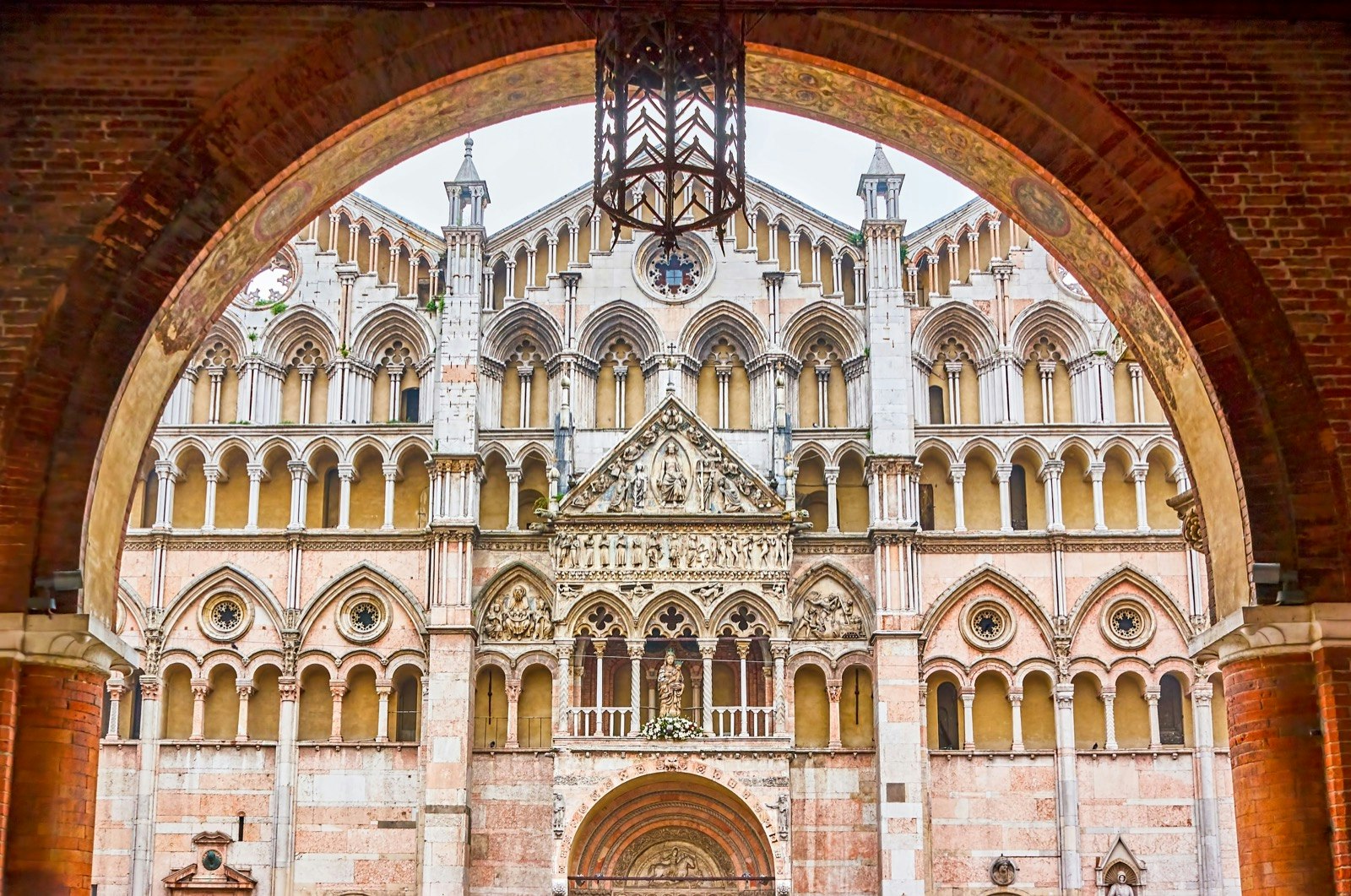
7. Travel back in time to mysterious Ferrara
Travel time: About one hour by train
Often mist-swirled and always mysterious, Ferrara is a time machine back to the Renaissance period. The Castello Estense, the ominous brick castle of the Este dynasty, dominates the city – today you can go for a boat ride in the moat that once separated the family from their citizens and mooch through the castle which, 500-odd years ago, was one of Italy’s cultural capitals. Fancy a taste of their lifestyle? Much of Ferrara’s traditional food comes from the Este family’s Renaissance cookbook – try pasticcio, a sweet-pastry pie filled with macaroni cheese, meat ragù and bechamel sauce, and salama da sugo, a spicy kind of sausage, served with mash and said to be Lucrezia Borgia’s favorite food. Both are acquired tastes, but a fascinating glimpse into how they ate hundreds of years ago.
Ferrara’s Palazzo dei Diamanti, an exhibition space in a 15th-century palace whose façade is studded with diamond-shaped stones, reopened in 2023 after two years of closure. It was originally damaged in the 2012 earthquake, along with much of the city. Check out its website for what’s on during your visit – its exhibitions are usually top notch and well worth the trip.
Until the Second World War, Ferrara had a renowned Jewish community; this was the setting for The Garden of the Finzi-Continis, by Giorgio Bassani, and you can still wander the narrow streets of what used to be the Jewish quarter. Learn the history of the community – both here and more widely in Italy – at the exceptional MEIS, or National Museum of Italian Judaism and the Shoah.
How to get to Ferrara from Venice: It’s easiest to go by rail. High-speed trains take just over an hour, while regional ones are around 90 minutes. Otherwise, it’s an easy 75-minute drive along the autostrada, but it’s a toll road and city center parking is expensive.

8. Eat some of Italy’s best food in Bologna
Travel time: 93 minutes by train
Where to go from Venice by train? Further than you think. By high-speed rail, it’s easy to turn Italy’s culinary capital into a daytrip. Step off the Frecciarossa (“red arrow” train) into La Rossa (“the red” – one of Bologna’s nicknames, along with “the learned” and “the fat”), for a day of shameless indulgence.
Wander the streets of the Quadrilatero (home to food stalls since the medieval period), take a pasta-making class (we like the offerings at Salumeria Bruno e Franco), and end with an aperitivo on Piazza Maggiore, Bologna’s main square, where a hulking naked statue-fountain of Neptune dominates one side, and the Basilica di San Petronio, a barn-like church, dominates the other. Any of the restaurants will do you proud – must-try dishes are tagliatelle al ragù, tortellini in brodo (tiny pasta pockets filled with a meaty, cheesy stuffing and swimming in broth), and cotoletta alla petroniana, or alla bolognese – a veal cutlet swathed in prosciutto, layered with cheese, then baked to oozing perfection.
How to get to Bologna from Venice: It’s easiest by train – high-speed Frecciarossa trains can whisk you there in just over an hour and a half. It’s roughly the same by car, though you should add autostrada tolls and the road is quite monotonous.
9. Climb into the Dolomites at Cortina d’Ampezzo
Travel time: Two hours by car
Within a two-hour drive from Venice, you can be in the heart of the Dolomites. Head due north, and within an hour you’ll be winding up through mountain passes towards Pieve di Cadore, the birthplace of Renaissance painter Titian (his birthplace is now a museum, and there are paintings by his artist family in the local church). From there, fork west, hugging the mountainsides, to Cortina d’Ampezzo.
This is one of Italy’s chi-chiest ski resorts, but there’s plenty to do year round, from hiking to eating (try the Michelin-starred SanBrite, whose owners source all their ingredients locally). This is part of the Ladin community, an ancient population of the mountains that have their own language and traditions. Learn about the Ladins, and the Regole – essentially a collection of centuries-standing families who "govern" the town – at the Ethnographic Museum, housed in an old sawmill.
How to get to Cortina d’Ampezzo from Venice: This is definitely one to drive. The two hours by car (or 80 minutes from Venice Marco Polo airport) changes to a minimum of five and a half by public transport and you’ll have to change at least twice.
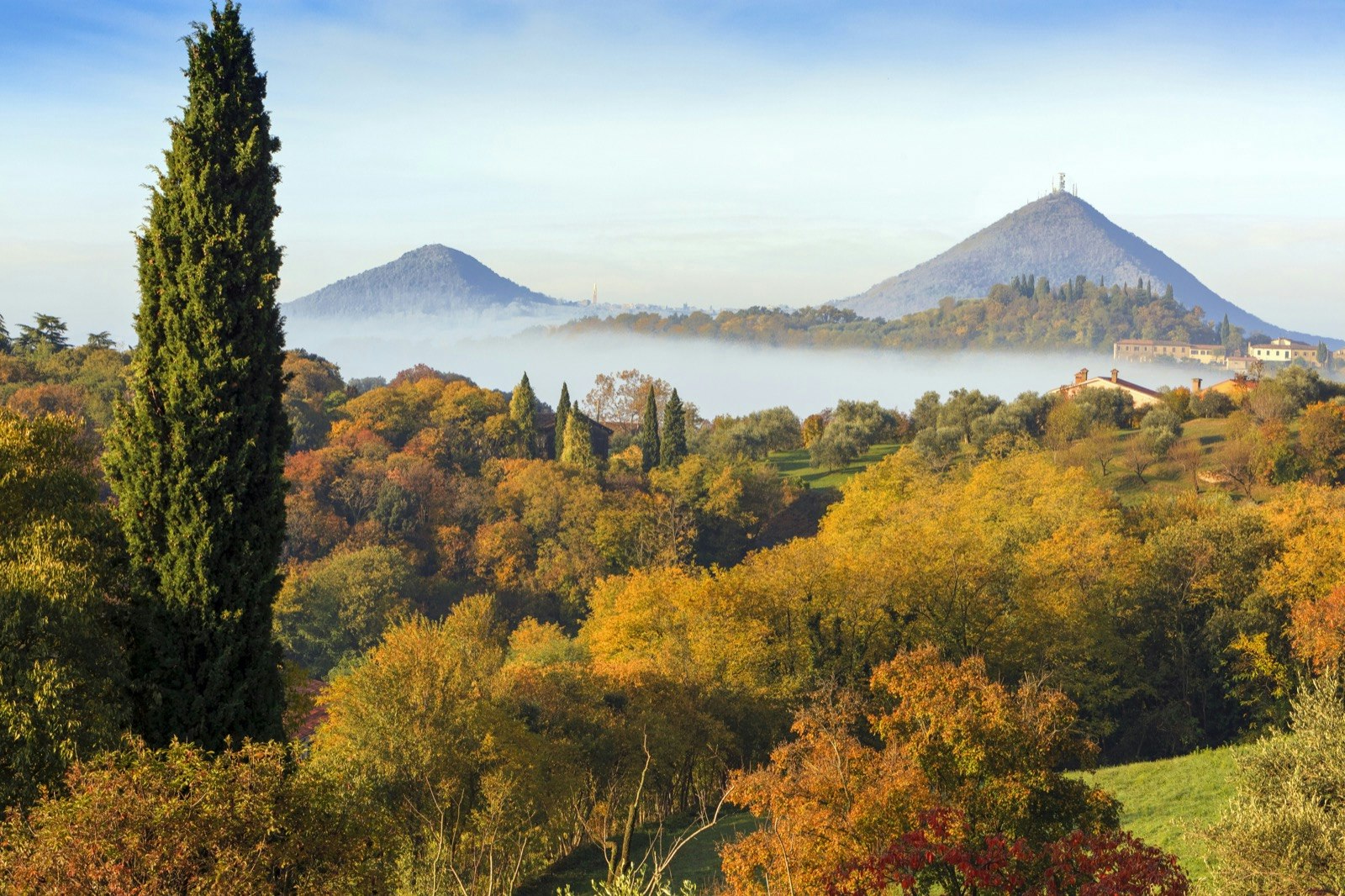
10. Wallow in volcanic mud in the Euganean Hills
Travel time: 45 minutes by car or train
The wider region around Venice, Veneto, tends to be pretty flat except where the landscape rears up towards the Dolomites. This is one of the exceptions – a group of cone-like volcanic hills, 81 of them to be precise, rearing up from the plains south of Padova.
Of course, their volcanic origin should give you a hint that Italy’s famous thermal spas will be nearby. The small, neighboring towns of Montegrotto and Abano are home to various springs and spas that have been going since Roman times. Today, along with other nearby towns Galzignano, Battaglia and Teolo, they’re said to form the oldest, and largest, thermal spa in Europe, with 240 thermal pools between them. One of our favorites is the Abano Ritz Hotel Terme – family- and female-owned for three generations. The thermal mud they use in balneotherapy treatments comes from right beside the hotel and the pools in their 6,000-square-meter waterpark stay a constant 33 degrees (91.4F), thanks to the thermal waters that spent 25 years and 100km (62 miles) underground before gushing out here.
Don’t spend all your time wallowing, though – the whole area is designated the Euganean Hills Regional Park, and there are trails for hiking, biking and horse-riding, as well as breathtaking views from behind the wheel if you prefer a road trip. Visit one of the sprawling Renaissance country villas on offer (try Villa Barbarigo, known as the hills’ answer to Versailles, near Galzignano). Can’t go to Italy without seeing some Roman remains? You’ll find bits of 2000-year-old spas at Montegrotto and Abano.
How to get to the Euganean Hills from Venice: Trains take between 37 minutes and an hour to reach the Terme Euganee-Abano-Montegrotto station, which serves the spa towns. If you want to explore the park, though, you’ll need a car – it’s about a 45-minute drive from Venice.
11. Wind back the centuries at Aquileia
Travel time: 80 minutes by car
Across the border in Friuli Venezia Giulia and en route to Trieste is this fascinating time capsule, where the history of the northern Adriatic is layered like a lasagne. Now a Unesco World Heritage site, this was one of the richest cities of the early Roman Empire before it was destroyed by the Huns in the fifth century CE. There’s not a lot from that era visible, since most of it lies unexcavated below fields, although the Roman river port is fascinating in its detail.
What you’re really going for is the later history – the basilica, dating back to the fourth century and rebuilt in the medieval period after an earthquake. The original mosaic floor was saved from damage and today it’s an astonishing, colorful carpet of early Christian artwork, with astonishingly vivid depictions of Bible stories like the Good Shepherd and Jonah and the whale, in between cameos of rich Roman locals, and lagoon wildlife.
How to get to Aquileia from Venice: The easiest way to get there is by car; it’s about an hour and 20 minutes’ drive from Venice, and about two thirds of the way to Trieste. By public transport you’ll need to take a train to Cervignano-Aquileia-Grado and then swap to a bus – the journey takes just over two hours.
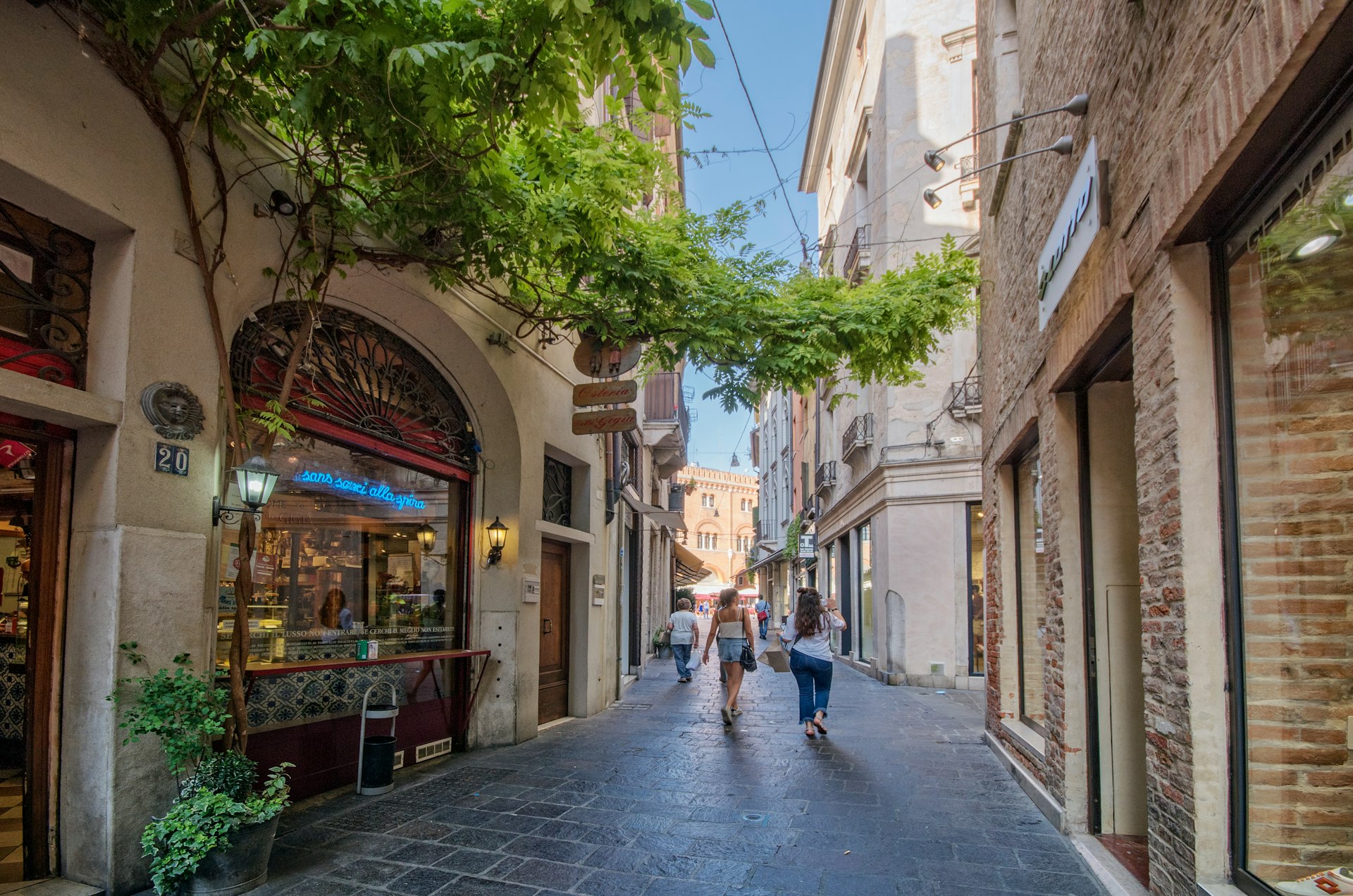
12. Visit Venice’s inland empire at Treviso
Travel time: 31 minutes by train
These days, Treviso is best known for its airport, home to budget airlines galore, but there’s nothing low-end about the town itself. Elegant, petite and pretty, Treviso is still a place for residents rather than tourists, and a walk around its calm centro storico is like one big exhale if you’ve come from crowded Venice. Once part of the Stato da Tera, Venice’s historic inland empire, it’s curiously similar to La Serenissima – all porticoes, art-filled churches and elegant palazzos – only without canals taking center stage (though there are a few – the Canale dei Buranelli, sweeping through the center, is the prettiest).
Don’t miss the Fontana delle Tette, a fountain in the shape of a naked woman which used to spout wine from her breasts – white from one, and red from the other – every time a new mayor was sworn in. The original has been moved to the Palazzo dei Trecento, the 13th-century castle-like building dominating the Piazza dei Signori but there’s a replica in situ just off Calmaggiore, the main street dating back to Roman times. The church of San Nicolò is a beautiful example of Gothic architecture, which you won’t find much in Venice.
How to get to Treviso from Venice: Trains run every half hour or so, and take 30-40 minutes to Treviso Centrale. Otherwise, it’s a simple, if not particularly scenic, 40-minute drive from Piazzale Roma.

